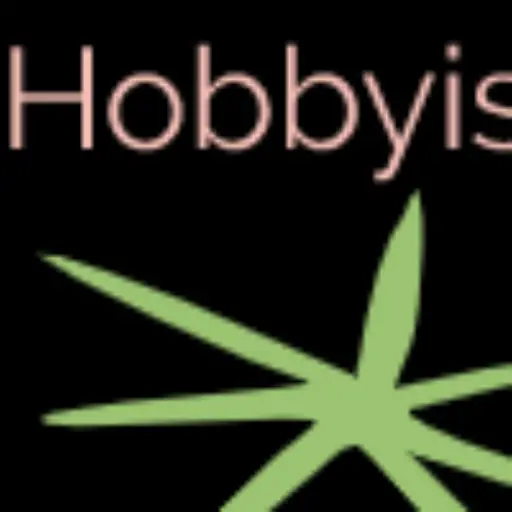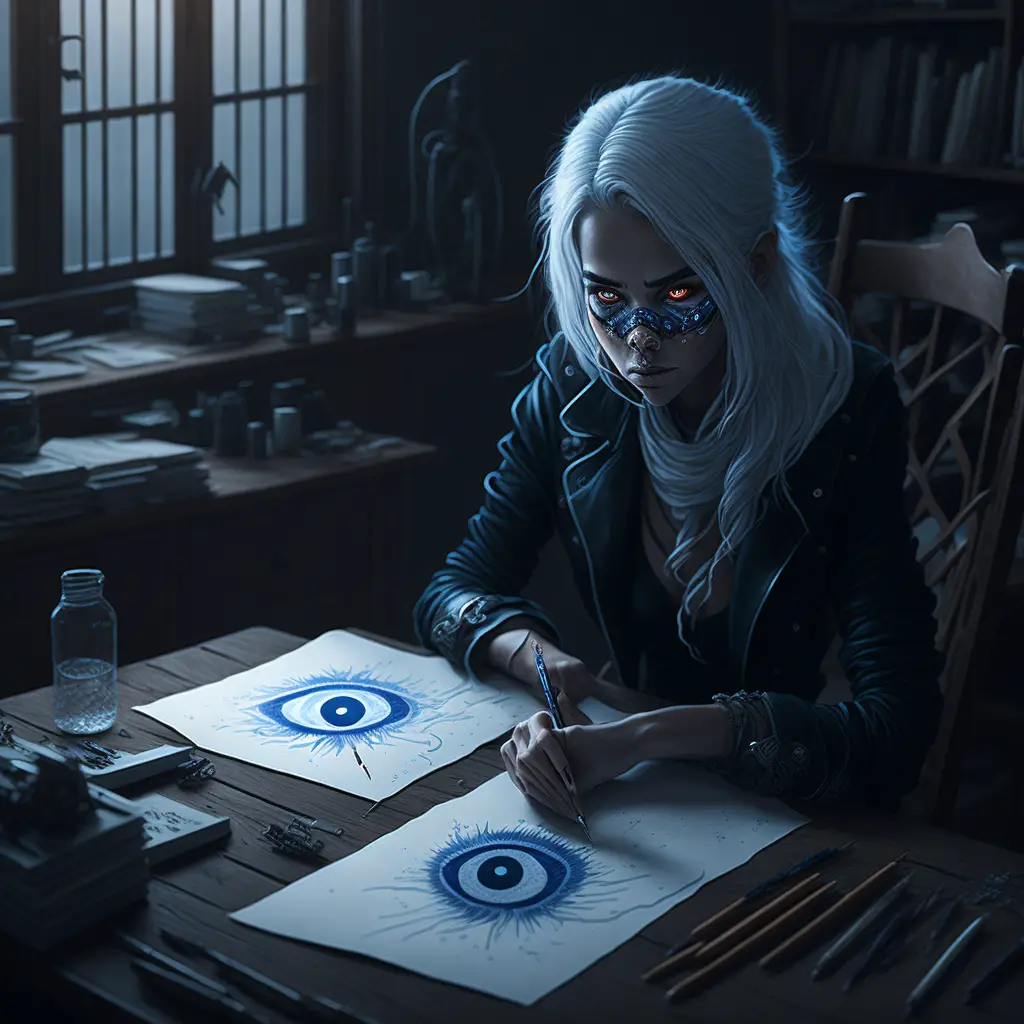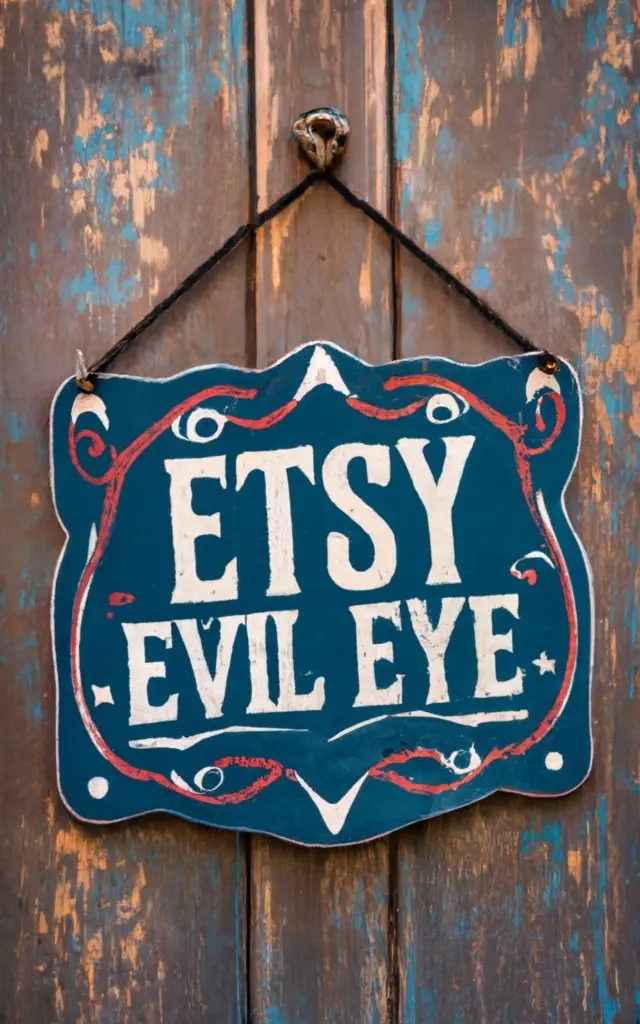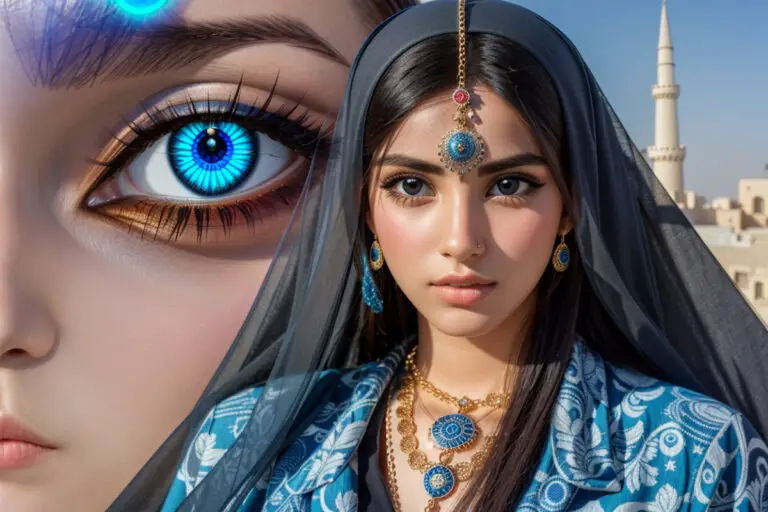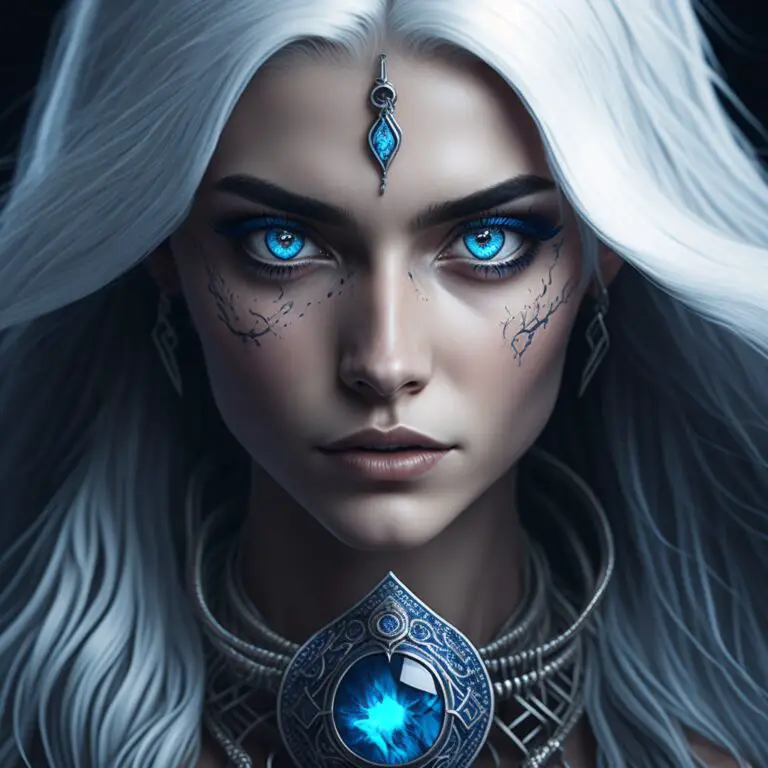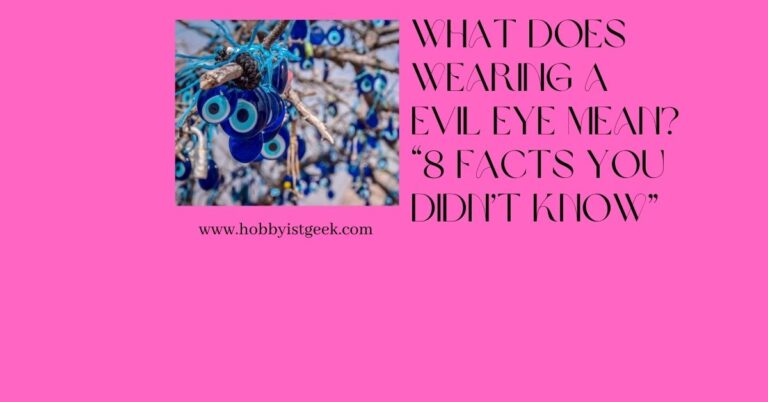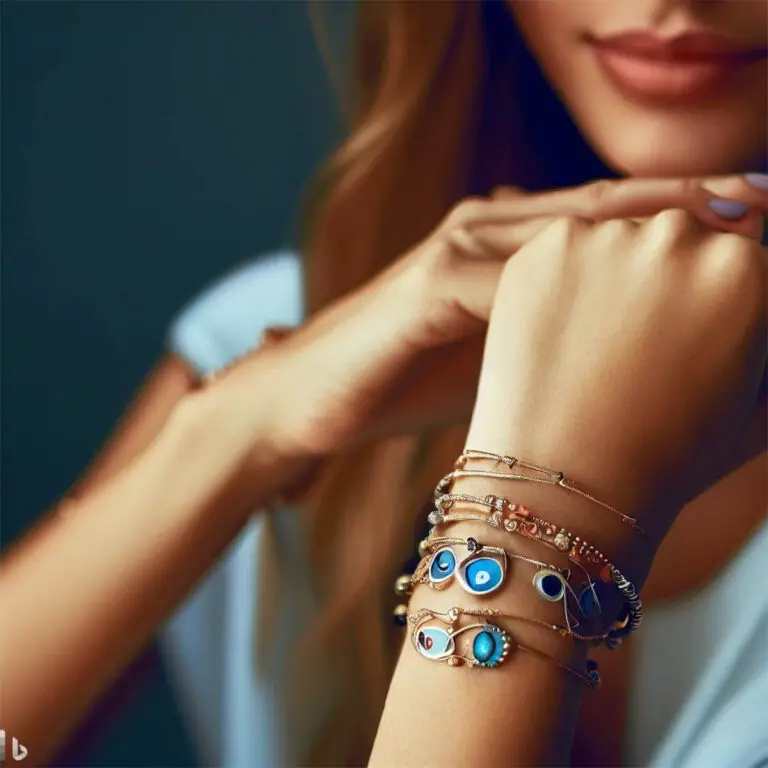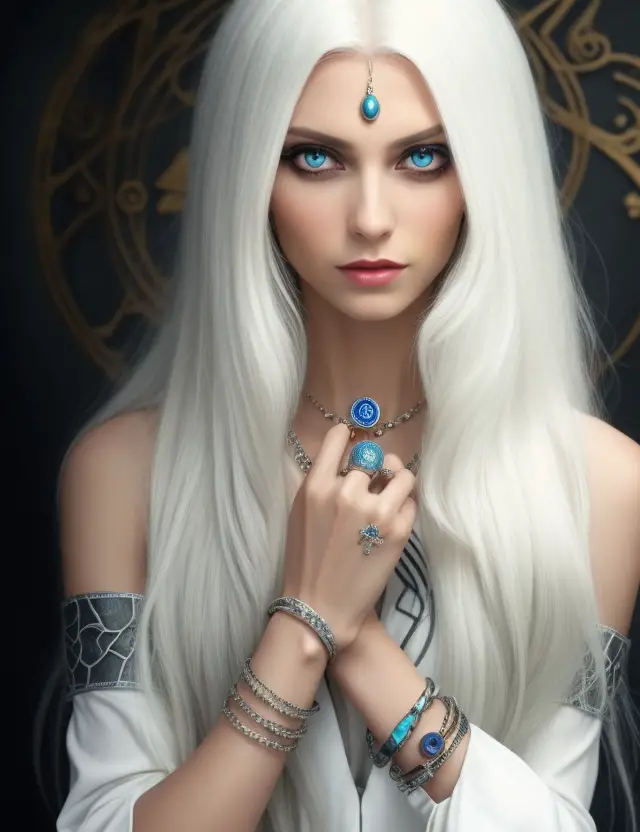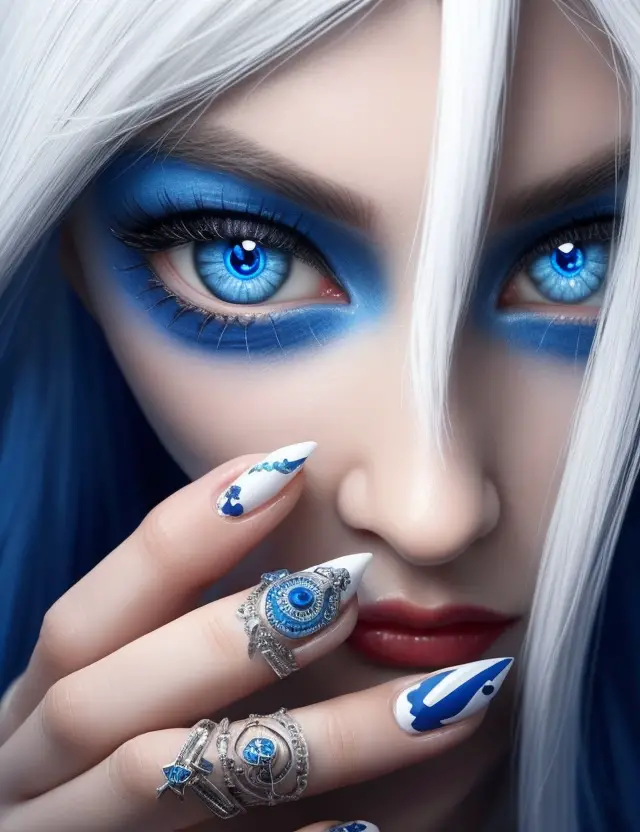Evil Eye Drawing: Unveiling the Art of Protection!
Introduction
Evil Eye Drawing The evil eye is a symbol that has been present in many cultures for thousands of years.
It is believed to be a curse brought about by a malevolent glare, usually inspired by envy, and is thought to have the ability to cause injury or death to those on whom it falls
The symbol of the evil eye has been used throughout the centuries to ward off curses or malicious intent and is recognized worldwide6.
This table provides a comprehensive overview of the evil eye symbol, its history, and its various aspects.
| Topic | Information |
|---|---|
| History and Cultural Significance | – Originating in various cultures, the evil eye symbol is believed to protect against malevolent glares and negative energy. |
| – It has roots in Mediterranean, Middle Eastern, and Asian cultures. | |
| Traditional Colors and Motifs | – Traditional evil eye colors include blue, white, and black. |
| – Common motifs include concentric circles and an eye-like design. | |
| Techniques for Creating an Evil Eye Drawing | – Drawing an evil eye often involves intricate detailing. |
| – Common techniques include pen and ink, watercolor, or digital illustration. | |
| Incorporating Evil Eye Drawings into Home Decor | – Evil eye drawings can be framed and hung as wall art. |
| – They are used on textiles, pottery, and jewelry for decorative purposes. | |
| Famous Examples in Art History | – Ancient Egyptian eye of Horus and Byzantine amulets. |
| – Salvador Dali’s “The Eye” and contemporary artists’ interpretations. | |
| Tips for Creating a Unique and Personalized Evil Eye Drawing | – Experiment with color schemes and patterns. |
| – Incorporate personal symbols or protective elements. | |
| Popular Mediums for Creating Evil Eye Drawings | – Watercolor, acrylic, digital art, and ink are common choices. |
| – Glass and ceramic are used for creating 3D evil eye talismans. | |
| Cultural Variations of the Evil Eye Symbol | – Blue glass beads in Greece, Hamsa hand in Middle Eastern cultures. |
| – Nazar Boncugu in Turkey, Nain in India. | |
| Common Themes or Motifs in Evil Eye Drawings | – Eyes, hands, owls, and geometric patterns. |
| – Use of concentric circles and vibrant colors. | |
| Evolution of the Evil Eye Symbol | – Originally a protective amulet, it has become a popular design element. |
| – Evolving from traditional to contemporary art, it embraces diverse styles. |
To delve deeper into the significance of the evil eye symbol, visit https://www.hobbyistgeek.com/.
There, you’ll discover articles exploring the science and cultural importance of the evil eye, traditional colors and motifs used in its depictions, techniques for crafting an evil eye drawing, ideas for incorporating it into home decor, notable examples in art history, and insights into its evolution over time.
Explore various mediums, cultural variations, common themes, and tips for creating a unique and personalized evil eye drawing.
What is the history and cultural significance of the evil eye symbol?
The evil eye symbol is a fascinating aspect of cultural history that has captivated people for centuries. Its origins can be traced back to ancient civilizations such as the Greeks and Romans, who believed in its power to ward off bad luck and protect against harm. The symbolic eye, often depicted as a pen drawing or ink drawing, has been used as an explanatory model to understand misfortune and the power of jealousy.
In many cultures, the evil eye is seen as a collection of beliefs and practices centered around protection from malevolent gazes. People have long worn amulets decorated with the iconic eye motif, believing that it would deflect any negative energy directed towards them.
These amulets are often intricately designed, showcasing the cultural significance attributed to this symbol. Artists throughout history have also incorporated the evil eye into their work, creating stunning pieces that showcase its power and allure.
For example, in ancient Roman art, the Mithraic Bull-Wounding Scene prominently features an evil eye symbol to convey protection and strength. In the contemporary art world too, artists have embraced the symbolism of the evil eye through various mediums.
Online platforms such as Saatchi Art offer original artwork featuring abstract interpretations of this powerful talisman. The appeal of minimalistic or abstract art styles allows for unique and personalized representations of this enduring symbol.
Moreover, the evil eye has transcended beyond traditional amulets and artwork. It has found its way into various aspects of modern life – from apparel adorned with protective eyes to home decor items featuring intricate evil eye drawings – allowing individuals to incorporate this potent symbol into their everyday lives.
Overall, understanding the history and cultural significance of the evil eye provides us with a deeper appreciation for its enduring presence in our society. Whether displayed as a Byzantine amulet or reimagined in minimalist contemporary art, it continues to captivate people’s imagination while serving as a timeless reminder of protection against ill intentions.
What are some traditional colors and motifs used in evil eye drawings?
When it comes to traditional colors and motifs used in evil eye drawings, there is a rich tapestry of choices to explore. In terms of colors, the most prevalent hues are typically deep blues and vibrant blues, symbolizing protection and spiritual energy.
These shades often dominate evil eye drawings, creating a captivating visual impact. However, it’s not uncommon to see variations with other colors like black, white, or even red incorporated into the design.
Each color adds its own unique meaning – black for warding off negative energy, white for purity and clarity, and red for strength and vitality. Moving on to motifs, the evil eye drawing offers a plethora of designs that reflect its cultural significance across different regions.
One of the most common motifs found in evil eye drawings is the “nazar” symbol—a concentric circle with a dark blue iris-like center surrounded by white or light blue circles. This motif is inspired by ancient talismans known as amulets which were believed to possess protective powers against the evil eye.
Another popular motif frequently seen in evil eye drawings is the “Hamsa Hand,” which originates from Middle Eastern culture. This hand-shaped symbol features an eye embedded within its palm and serves as another potent talisman against malevolent forces.
Apart from these traditional motifs, many contemporary art styles have also embraced the concept of the evil eye drawing. Artists have incorporated abstract art techniques into their creations while maintaining reverence for this age-old symbol of protection.
These modern interpretations allow for more experimental approaches using different mediums such as pen drawing or ink drawing. Overall, whether you appreciate minimalist art or crave detailed artwork with intricate patterns and designs, there is an extensive collection of possibilities when it comes to exploring traditional colors and motifs in evil eye drawings.
So go ahead, let your creativity flow as you create your very own original piece inspired by this fascinating protective amulet! And if you’re looking for inspiration or desire to add a unique evil eye drawing to your collection, platforms like Saatchi Art can be an excellent resource to discover talented artists showcasing their interpretations of this captivating symbol.
What are some techniques for creating an evil eye drawing?
When it comes to creating an evil eye drawing, there are various techniques you can use to bring this mystical symbol to life. One popular technique is using pen drawings, which allow for intricate details and precise lines.
You can start by sketching the basic shape of the eye, ensuring that it is symmetrical and proportionate. Then, you can add in the characteristic features such as the iris and pupil.
Experiment with different patterns and designs within the eye, incorporating swirls or geometric shapes to give it a unique touch. Another technique is ink drawing, which creates a bold and striking effect.
You can use different shades of ink to create depth and contrast within the drawing. Additionally, if you have a penchant for color, you can explore incorporating vibrant hues into your evil eye drawing using markers or watercolors.
This adds an extra layer of visual appeal and allows you to experiment with different color combinations that resonate with your artistic vision. To further enhance your evil eye drawing skills, it’s helpful to study existing artwork featuring this symbol for inspiration.
Look into traditional Byzantine amulets or ancient depictions like the Mithraic Bull-Wounding Scene for historical references that showcase unique stylistic elements. Contemporary art platforms like Saatchi Art also offer a wide range of evil eye-inspired artwork that combines traditional motifs with contemporary interpretations.
By studying these pieces, you can gain insight into various artistic approaches while adding your own personal flair. Remember that creating an original evil eye drawing is not just about replicating existing designs; it’s also about infusing your own creativity into it.
Embrace minimalist art if that aligns with your style preference or explore abstract art techniques to give your composition a more unconventional twist. Ultimately, what matters most is creating an evil eye drawing that resonates with you personally while maintaining respect for its cultural significance as a powerful amulet against malevolent forces.
Whether you choose pen drawings, or ink techniques, or explore color variations, the key is to let your imagination flourish and create an evil eye drawing that reflects your own artistic voice. So, grab your pen or paintbrush and let the magic of this ancient symbol guide your artistic journey!
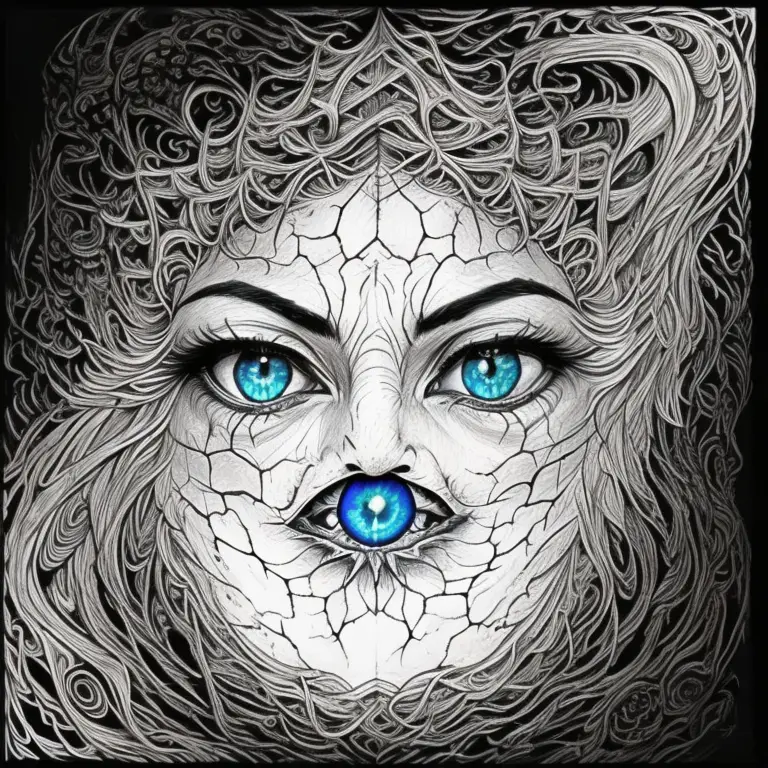
How can I incorporate an evil eye drawing into my home decor?
When it comes to incorporating an evil eye drawing into your home decor, the possibilities are endless. One popular way to showcase this ancient symbol of protection is by using it as an amulet.
Hang a small evil eye drawing on a wall near your entryway to ward off any negative energy that might try to sneak its way in. You can also wear evil eye drawings as jewelry, like pendants or bracelets, to carry the protective energy with you wherever you go.
If you’re looking for a more artistic approach, consider incorporating an evil eye drawing into your artwork collection. There are numerous contemporary artists who have created stunning pieces featuring this powerful symbol.
From ink drawings to pen and minimalist art, there’s something for every taste and style. Websites like Saatchi Art offer a wide range of original and unique evil eye drawings that can truly elevate the aesthetic of your space.
In terms of home decor, another option is to include an evil eye drawing as part of a larger artwork display. For example, you could create a gallery wall where the central focus is an intricate evil eye drawing surrounded by other complementary pieces.
This allows you to blend different art styles and create a visually captivating arrangement that sparks conversation. For those who prefer subtlety, incorporating an evil eye drawing in smaller ways can be just as effective.
You can opt for throw pillows or blankets adorned with the symbol, bringing both comfort and protection into your living space. Additionally, there are apparel options such as t-shirts or tote bags featuring beautiful evil eye designs that you can proudly wear or use in everyday life.
Regardless of how you choose to incorporate an evil eye drawing into your home decor, remember its cultural significance and the centuries-old belief in its protective powers. The key is finding pieces that resonate with you personally while honoring this ancient symbol’s history and meaning – whether through traditional motifs or more abstract interpretations – ensuring that its presence brings both beauty and positive energy into your home.
What are some famous examples of evil eye drawings in art history?
When exploring the world of evil eye drawings in art history, one cannot overlook the captivating works that have left an indelible mark on our cultural heritage. From ancient civilizations to contemporary artists, the evil eye symbol has been a source of inspiration for countless masterpieces.
One prominent example is the Byzantine amulet with an intricately detailed evil eye design. Dating back to the 6th century, this amulet showcases the intricate craftsmanship and devotion to symbolism prevalent during that era.
The pen drawing technique employed in creating this piece allows for precise lines and delicate shading, bringing out the beauty and mystique of the evil eye. Moving forward in time, we encounter ink drawings that feature the evil eye as part of larger narrative scenes.
One such notable example is found in a Mithraic Bull-Wounding Scene from ancient Rome. This artwork depicts a mythological tale where Mithras wounds a bull, with an evil eye prominently placed within the composition.
Through these art pieces, we witness how the evil eye served not only as a protective talisman but also as an integral element within stories of power and divine intervention. In more recent times, contemporary artists have embraced minimalism and abstraction while incorporating the symbolic power of the evil eye into their work.
Saatchi Art boasts an impressive collection of such artwork, where artists experiment with various mediums and styles to present their unique interpretations. These pieces range from large-scale paintings featuring bold colors and expressive brushstrokes to smaller-scale minimalist compositions that convey profound messages through simplicity.
The beauty of exploring famous examples of evil eye drawings lies not only in appreciating their artistic merits but also in understanding how they continue to resonate with audiences today. These artworks serve as reminders of our shared human fascination with symbolism, spirituality, and protection against malevolent forces.
By delving into art history’s treasure trove, we gain insight into how this ancient protective amulet has evolved over time while retaining its cultural significance. So, whether you encounter the evil eye in traditional amulets, original pen drawings, or contemporary abstract art pieces, let it be a captivating reminder of our collective human desire for protection and connection.
What are some tips for creating a unique and personalized evil eye drawing?
When it comes to creating a unique and personalized evil eye drawing, there are several tips and tricks that can help you make your artwork stand out. Firstly, consider incorporating elements from your own culture or personal experiences.
The evil eye symbol has a rich cultural significance across various traditions, so by infusing your own background into the drawing, you can create an artwork that resonates with your identity. Secondly, experiment with different styles and techniques.
Evil eye drawings can range from intricate and detailed to minimalist and abstract art. Explore different mediums such as pen or ink drawing, or even digital art if that’s your thing.
Don’t be afraid to let your creativity take the lead! Another tip is to add a touch of originality by taking inspiration from other art forms or historical examples.
For instance, you could draw upon elements from Byzantine amulets or incorporate motifs from famous artworks like the Mithraic Bull-Wounding Scene. Consider the context in which your evil eye drawing will be displayed.
Whether it’s for personal use as an amulet for protection or as part of a larger artistic collection on display in a gallery like Saatchi Art, think about how the artwork will interact with its surroundings or how it would look on apparel or home decor items. By following these tips, you’ll be able to create an evil eye drawing that is not only visually captivating but also deeply meaningful and unique to you
What are some popular mediums for creating evil eye drawings?
When it comes to creating evil eye drawings, there are several popular mediums that artists often employ to bring their visions to life. One of the most traditional mediums is pen drawing, which allows for intricate details and precise lines. Artists can use different types of pens, such as fine liners or dip pens with various nib sizes, to achieve the desired effect.
The use of ink in evil eye drawings also adds depth and richness to the artwork, making it visually captivating. In addition to pen and ink drawings, contemporary artists have explored other mediums to create their own interpretations of the evil eye symbol.
Some artists experiment with abstract art, using bold colors and fluid brushstrokes to evoke a sense of mystery and intrigue. Others opt for minimalist art, focusing on simplicity and clean lines to convey their message.
These unique approaches allow for a fresh take on the traditional evil eye drawing while still maintaining its cultural significance. Moreover, evil eye drawings are not limited to two-dimensional artwork alone.
Artists have also incorporated this powerful symbol into three-dimensional pieces such as sculptures or installations. By pushing the boundaries of traditional mediums, these artists bring a new dimension and perspective to the concept of evil eye protection.
Whether it’s a beautiful pen drawing on paper or an elaborate sculpture meant for display in your home or collection, exploring different mediums allows artists to express themselves while keeping the essence of this ancient symbol intact. The choice of medium ultimately depends on individual preferences and artistic style; what matters most is capturing the essence and power behind the evil eye in an original way that resonates with both creator and viewer alike.
What are some cultural variations of the evil eye symbol?
The evil eye symbol has a rich and diverse history, with various cultural variations that have emerged over time. One popular variation of the evil eye can be found in the amulets of the Middle East. These amulets are often made from blue glass or other materials and are believed to protect against the malevolent gaze.
The cultural significance of these amulets runs deep, as they are passed down through generations as protective talismans. In contemporary art, the evil eye symbol has also found its place.
Artists have taken inspiration from its mysterious allure and incorporated it into their works. From minimalist art to intricate pen drawings, the evil eye is depicted in various styles and mediums.
Some artists explore the symbolism behind the evil eye, while others use it as a decorative element in their artwork. One famous example of an evil eye variation can be seen in Byzantine amulets.
These amulets often feature detailed depictions of eyes, surrounded by intricate patterns and symbols. They were widely used in Byzantine culture for protection against the malevolent forces that could bring harm.
The evil eye symbol has also made its way into fashion and apparel. Many designers incorporate this ancient symbol into their designs, creating unique pieces that carry both aesthetic appeal and a sense of protection.
Whether it’s an abstract art print on a t-shirt or an ink drawing on a scarf, wearing these items allows individuals to express their belief in warding off negativity. Exploring different cultural variations of the evil eye symbol not only expands our understanding but also opens up new avenues for creativity and artistic expression.
From traditional amulets to contemporary interpretations, this ancient motif continues to captivate artists and enthusiasts alike with its timeless appeal. The cultural variations of the evil eye symbol offer fascinating insights into different beliefs and artistic expressions across various cultures throughout history.
From traditional amulets rooted in ancient customs to contemporary artworks that push boundaries, the versatility and enduring popularity of the evil eye symbol continue to make it a significant presence in our world today. Whether as a protective talisman, an artistic motif, or a fashionable accessory, the evil eye serves as a powerful reminder of our shared human fascination with symbolism and protection against negativity.
What are some common themes or motifs in evil eye drawings?
When it comes to evil eye drawings, there are a few common themes and motifs that you’ll often find. These elements help to convey the essence of protection and ward off negativity.
One such theme is the “all-seeing eye,” which represents an omnipresent force that can perceive all things, including malevolent gazes. This motif is often depicted as a single eye in the center of the drawing, surrounded by intricate patterns or symbols.
Another common theme is the use of vibrant colors, such as blue and turquoise, which are believed to possess protective qualities in many cultures. These hues add an element of visual appeal while also enhancing the symbolic power of the drawing.
In addition to these themes, certain symbols frequently appear in evil eye drawings. One prominent symbol is the Hamsa hand, which originated in Middle Eastern cultures and has become popular worldwide as a symbol of protection against negative energies.
The Hamsa hand features an open palm with an eye at its center, representing both strength and vigilance against harm. Other symbols include geometric shapes like triangles or circles, which are believed to have mystical properties that can repel evil forces.
Evil eye drawings also often incorporate elements from different art styles and periods. For instance, in contemporary art, you might find minimalist interpretations where only essential lines and colors are used to depict the evil eye symbol.
On the other hand, Byzantine amulets dating back centuries showcase intricate ink drawings with exquisite details. Moreover, evil eye drawings can serve various purposes beyond just decorative artwork.
They can be utilized on apparel items like t-shirts or accessories as a way for individuals to carry protection with them wherever they go. Additionally, artists create original pieces using different mediums like pen drawing or abstract techniques to express their unique interpretation of this ancient symbol.
It’s worth mentioning that if you’re interested in exploring a wide range of evil eye drawings by talented artists from around the world, websites like Saatchi Art offer an extensive collection to choose from. This allows you to find a piece that resonates with your personal aesthetic and connects you to the cultural significance of the symbol.
Common themes and motifs found in evil eye drawings encompass the all-seeing eye, vibrant colors, and symbolic elements like the Hamsa hand or geometric shapes. These drawings can be created in various styles, ranging from minimalist art to intricate ink drawings.
Evil eye artwork goes beyond mere decoration, often serving as a protective amulet or an expression of an artist’s interpretation of this ancient symbol. So if you’re seeking a unique piece of art that carries both visual appeal and spiritual significance, consider exploring the diverse world of evil eye drawings.
How has the evil eye symbol evolved over time?
Over the course of history, the evil eye symbol has undergone a fascinating evolution, adapting to different cultures and artistic styles. From its origins in ancient civilizations to its presence in contemporary art, this symbol has remained a powerful icon of protection.
In ancient times, evil eye drawings were often intricate and detailed, featuring complex patterns and vibrant colors. For example, Byzantine amulets showcased the evil eye symbol with elaborate goldwork and gemstones, reflecting the opulence of the era.
As time progressed, the evil eye symbol began to appear in various forms of artwork. In medieval Europe, ink drawings depicted this symbol with meticulous precision and shading techniques.
These detailed illustrations not only showcased the mastery of artists but also embodied the cultural significance attached to warding off negative energies. In more recent centuries, there was a shift towards minimalist art styles that influenced evil eye drawings.
Artists started experimenting with simpler designs while still capturing the essence of protection against malevolent forces. Pen drawings became popular for their clean lines and striking visuals.
Today, contemporary artists continue to explore new ways to interpret and represent the evil eye symbol through their artwork. Some choose a more abstract approach by creating unique compositions that evoke feelings of mysticism and spirituality.
Others incorporate the symbol into modern themes or use it as a statement piece in larger collections. The evolution of the evil eye symbol is not limited to visual art; it has also found its way into other forms such as apparel and accessories.
Designers have embraced this captivating motif by incorporating it into clothing designs or crafting exquisite jewelry pieces adorned with protective eyes. From ancient times to present-day society, the evil eye symbol has transformed artistically while preserving its essence as a protective talisman.
The journey through time reveals how artists have interpreted this powerful icon using various techniques like intricate goldwork in Byzantine amulets or minimalistic pen drawings in contemporary art. This ongoing evolution demonstrates that despite changing artistic styles, the cultural significance of the evil eye as an explanatory model for warding off negative energies continues to captivate and inspire artists worldwide.
Conclusion for Evil Eye Drawing
Evil Eye Drawing: Unveiling the Art of Protection offers a captivating journey into the rich history and cultural significance of this ancient symbol. From its origins as a powerful amulet in Byzantine times to its popularity in contemporary art, the evil eye drawing has transcended time and continues to intrigue and inspire artists around the world.
Throughout this article, we explored the traditional colors and motifs commonly used in evil eye drawings, such as vibrant blues and intricate concentric circles. We also dived into various techniques for creating these drawings, whether it be with ink pens on paper or other mediums like acrylics on canvas.
The versatility of evil eye drawings allows for endless possibilities when it comes to incorporating them into home decor or personalizing them to reflect individual tastes. We delved into famous examples in art history where the evil eye drawing played a prominent role, such as in Mithraic Bull-Wounding Scene or modern collections showcased on platforms like Saatchi Art.
These artworks serve as testaments to the enduring appeal of this protective symbol. The ever-evolving nature of evil eye drawings was also explored, highlighting how they have adapted and changed over time while still retaining their core essence.
Whether you appreciate minimalist art or prefer abstract interpretations, there is an evil eye drawing out there that will speak to your aesthetic sensibilities. As we conclude our exploration into Evil Eye Drawing: Unveiling the Art of Protection, let us embrace not only the beauty but also the power that lies within this symbolic artwork.
Let it remind us that we have the ability to ward off negativity and protect ourselves from harm through artistry and creativity. So next time you encounter an original evil eye drawing or create one yourself, take a moment to appreciate its cultural significance and revel in its ability to bring positivity into our lives.
Frequently Asked Questions
- What is the history and cultural significance of the evil eye symbol?
Answer: The evil eye is a symbol that has been present in many cultures for thousands of years. It is believed to be a curse brought about by a malevolent glare, usually inspired by envy, and is thought to have the ability to cause injury or death to those on whom it falls[1][4]. - What are some traditional colors and motifs used in evil eye drawings?
Answer: Traditional colors used in Evil Eye drawings include blue, white, and black. Motifs often include concentric circles, teardrop shapes, and the image of an eye[1][2]. - What are some techniques for creating an evil eye drawing?
Answer: Techniques for creating an evil eye drawing include sketching the basic shape of the eye, adding details such as the iris and pupil, and incorporating traditional colors and motifs[1][2]. - How can I incorporate an evil eye drawing into my home decor?
Answer: Evil eye drawings can be incorporated into home decor in a variety of ways, such as wall art, throw pillows, or even as a design on a rug or tablecloth[1]. - What are some famous examples of evil eye drawings in art history?
Answer: Famous examples of evil eye drawings in art history include the Eye of Horus in ancient Egyptian art, the Hamsa hand in Jewish and Muslim art, and the Nazar Boncuk in Turkish art[1].
Check out more information on Evil Eye!
Unlock the Power of Evil Eye Protection!
Hobbyist Geek. Com
Explore HobbyistGeek.com today, where I’ve curated a wealth of articles covering everything you need to know about the Evil Eye.
Discover recommended materials, learn proper rituals, delve into color symbolism, and even find in-depth reviews of specific Evil Eye products to aid you in choosing the perfect one.
Strengthen your protection against the Evil Eye by visiting www.HobbyistGeek.com.
Don’t forget to sign up for our email list to stay updated with exclusive insights and offers.
Feel free to drop any questions you may have below – I’m here to guide your spiritual journey.
If you enjoyed this informative article I know you will love:
Is The Evil Eye Good Or Bad?: Explained
Evil Eye Bracelet Color Meaning: How Colors Influence Your Life!
- Jewelry Making Ideas: Seasonal Crystal Trends That Command Premium Prices - May 31, 2025
- Evil Eye Hand: Unveiling the Mystical Origins and Meanings - February 2, 2024
- Amegreen Amethyst Meaning: Discover the Hidden Magic! - February 2, 2024
